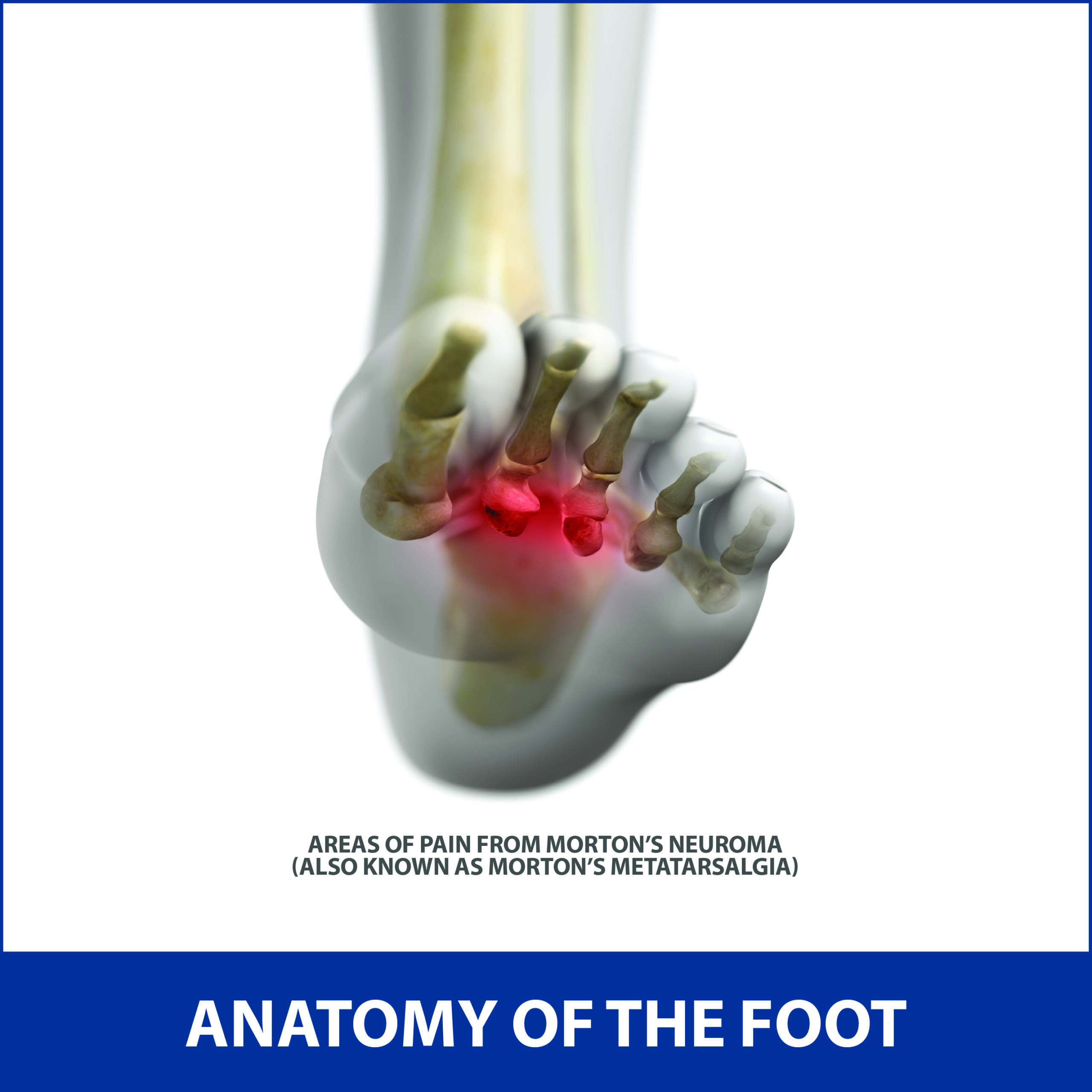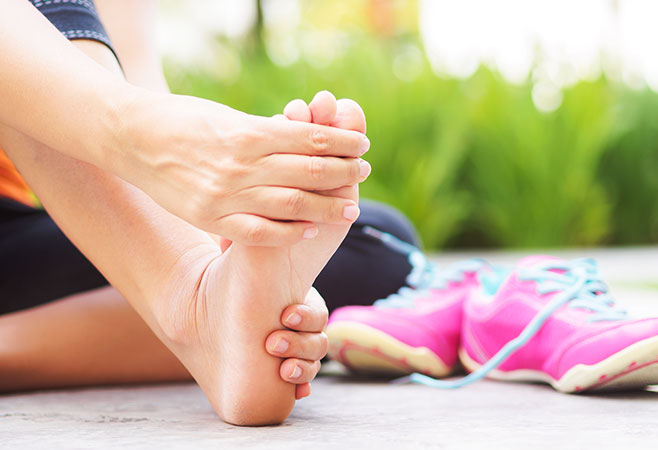Morton’s Neuroma
Overview
Morton’s Neuroma is a thickening of the tissue around nerves leading to the toes. The condition was first described by a chiropodist named Durlacher but is named after Dr. Thomas George Morton.
This condition is relatively common, with over 200,000 cases in the U.S. every year. It can be caused by pressure (from running or use of high heels) or injury.
Morton’s Neuroma may cause a sharp, burning pain or numbness in the ball of the foot or toes, or it can feel like there’s a pebble in your shoe or a fold in your sock.
Treatments include arch supports, footpads, corticosteroid injections, strength exercises, special shoes, and surgery.
Anatomy
Your feet are comprised of many bones, muscles, and soft tissues such as tendons and ligaments. Additionally, they contain many nerves.
A large group of nerves surrounds your toe bones (the metatarsals). Occasionally, the tissues near these nerves thicken and form a growth called a neuroma.
Under different circumstances, neuromas can be cancerous tumors. But orthopedists stress that Morton’s variety are benign and are not considered tumors.
Morton’s Neuroma is the official name given this condition, also known as Morton’s metatarsalgia. In most cases, this problem occurs between your third and fourth toe bones.

Causes
Researchers believe these abnormal growths are caused by repeated and intense pressure placed upon nerves. Several underlying factors may increase your risk of developing the condition:
- If you have been diagnosed with any type of foot problem, most notably issues like hammertoes, bunions, or flat feet, your chances of contracting the condition rise significantly.
- People who wear high heel shoes for professional or stylistic purposes. This footwear often places unnecessary strain on the ball of your foot and surrounding toe bones, which can lead to Morton’s Neuroma.
- Sports that place added stress on your feet increases your probability of developing neuromas. Of particular concern are activities such as running, rock climbing, and snow skiing.
- Studies have found that this problem is eight to ten times more likely to occur in women.

Symptoms
There is one common occurrence almost everyone eventually diagnosed with the condition experiences – a feeling that a rock is stuck in the bottom of your shoe or that your sock has a bulge that you cannot seem to straighten. Other notable symptoms include:
- A burning sensation in the ball of your foot.
- Tingling or numbness around the affected toe bones.
- Pain that worsens when wearing tight shoes.
- Discomfort that increases during strenuous activities.
- Pins and needles.
- Reduced sensation of touch.
- Lump in the sole of the foot.
- Sensation of walking on a marble.

Diagnosis
During your physical examination, your physician will thoroughly check the bottom of your foot for any growths. An official diagnosis may not be reached without the use of some diagnostic imaging test such as magnetic resonance imaging (MRI scans), X-rays, or ultrasound.
Though all these tests enable medical professionals to study internal images of your foot, many maintain ultrasound is most effective in detecting soft tissue problems like neuromas.
Treatment Overview
Most minor or uncomplicated cases respond well to simple lifestyle changes or homecare remedies. More severe cases or those causing associated complications (like nerve damage) may need surgery.
Non-Surgical Treatment Options
Common initial therapies include footwear alterations, orthotics, and steroidal injections.
Sometimes, a simple effort such as changing the shoes you wear can result in significant improvement. Using wider, less constricting shoes places far less pressure on your feet’s nerves and toe bones.
Orthotics are soft, cushion-like products inserted into your shoes. This padding is designed to make your shoes more comfortable and place less stress on your feet, which may reduce the chances of developing the nerve irritation often responsible for causing neuromas.
Steroid injections are used on moderate occurrences to reduce swelling and inflammation.
Patients often experience noticeable relief when a combination of these preceding therapies are employed.
Surgical Intervention
The most severe conditions may require surgery. Two types of surgical efforts are commonly undertaken – nerve removal and decompression.
- Nerve Removal – If the growth has grown to significant lengths or is causing considerable nerve damage, removing the neuroma and surrounding nerves may be needed.
- Decompression – Occasionally, more painful instances of the condition can benefit from decompression surgery. Surgeons alleviate pressure on impacted nerves by cutting away sections of other nearby structures like soft tissues.
Next Steps
If you believe you have Morton’s Neuroma and the associated discomfort interferes with your everyday life and activities, please contact us. Our foot specialists have extensive experience diagnosing and treating this condition. Talk to your Florida Orthopaedic Institute physician today to learn more about Morton’s Neuroma.
Areas of Focus
- Foot, Ankle & Lower Leg
- Achilles Tendinitis - Achilles Insertional Calcific Tendinopathy (ACIT)
- Achilles Tendon Rupture
- Achilles Tendonitis
- Ankle Fracture Surgery
- Ankle Fractures (Broken Ankle)
- Ankle Fusion Surgery
- Arthroscopic Articular Cartilage Repair
- Arthroscopy Of the Ankle
- Bunions
- Charcot Joint
- Common Foot Fractures in Athletes
- Foot Stress Fractures
- Hallux Rigidus Surgery - Cheilectomy
- Hammer Toe
- High Ankle Sprain (Syndesmosis Ligament Injury)
- Intraarticular Calcaneal Fracture
- Lisfranc Injuries
- Mallet, Hammer & Claw Toes
- Metatarsalgia
- Morton’s Neuroma
- Neuromas (Foot)
- Orthopedic Physician Or A Podiatrist? Definition of a Podiatrist
- Plantar Fasciitis
- Sports Foot Injuries
- Sprained Ankle
- Total Ankle Replacement
- Turf Toe
Specialties
- AC Joint Injuries
- Achilles Tendinitis - Achilles Insertional Calcific Tendinopathy (ACIT)
- Achilles Tendon Rupture
- Achilles Tendonitis
- ACL Injuries
- Ankle Fracture Surgery
- Ankle Fractures (Broken Ankle)
- Ankle Fusion Surgery
- Anterior Cervical Corpectomy & Discectomy
- Arthroscopic Articular Cartilage Repair
- Arthroscopic Chondroplasty
- Arthroscopic Debridement of the Elbow
- Arthroscopy Of the Ankle
- Articular Cartilage Restoration
- Artificial Disk Replacement (ADR)
- Aspiration of the Olecranon Bursa - Fluid In Elbow
- Atraumatic Shoulder Instability
- Avascular Necrosis (Osteonecrosis)
- Bankart Repair
- Basal Joint Surgery
- Bicep Tendon Tear
- Bicep Tenodesis
- Bone Cement Injection
- Bone Growth Stimulation
- Bone Health Clinic
- Broken Collarbone
- Bunions
- Bursitis of the Shoulder (Subacromial Bursitis)
- Calcific Tendinitis of the Shoulder
- Carpal Tunnel Syndrome
- Charcot Joint
- Chiropractic
- Clavicle Fractures
- Colles’ Fractures (Broken Wrist)
- Common Foot Fractures in Athletes
- Community Outreach
- Cubital Tunnel Syndrome
- De Quervain's Tenosynovitis
- Deep Thigh Bruising
- Degenerative Disk Disease
- Diffuse Idiopathic Skeletal Hyperostosis (DISH)
- Discectomy
- Discitis Treatment & Information
- Dislocated Shoulder
- Dupuytren’s Disease
- Elbow
- Elbow Bursitis
- Elbow Injuries & Inner Elbow Pain in Throwing Athletes
- Epidural Injections for Spinal Pain
- Finger Dislocation
- Flexor Tendonitis
- Foot Stress Fractures
- Foot, Ankle & Lower Leg
- Foraminotomy
- Fractured Fingers
- Fractures Of The Shoulder Blade (Scapula)
- Fractures Of The Tibial Spine
- Functional Nerve Transfers of The Hand
- Ganglion Cysts
- General Orthopedics
- Glenoid Labrum Tear
- Golfer's Elbow
- Groin Strains and Pulls
- Growth Plate Injuries Of The Elbow
- Hallux Rigidus Surgery - Cheilectomy
- Hammer Toe
- Hamstring Injuries
- Hand & Finger Replantation
- Hand & Wrist
- Hand Nerve Decompression
- Hand Skin Grafts
- Hand, Wrist, Elbow & Shoulder
- Heat Injury/Heat Prostration
- High Ankle Sprain (Syndesmosis Ligament Injury)
- Hip & Thigh
- Hip Arthroscopy
- Hip Dislocation
- Hip Flexor Strains
- Hip Fractures
- Hip Hemiarthroplasty
- Hip Impingement Labral Tears
- Hip Muscle Strains
- Hip Pointers and Trochanteric Bursitis
- Hyperextension Injury of the Elbow
- Iliopsoas Tenotomy
- Iliotibial Band Syndrome
- Impingement Syndrome of the Shoulder
- Interlaminar Implants
- Interlaminar Lumbar Instrumental Fusion: ILIF
- Interventional Pain Management
- Interventional Spine
- Intraarticular Calcaneal Fracture
- Joint Replacement
- Knee & Leg
- Kyphoplasty (Balloon Vertebroplasty)
- Kyphosis
- Labral Tears Of The Hip (Acetabular Labrum Tears)
- Laminectomy: Decompression Surgery
- Lateral Collateral Ligament (LCL) Injuries
- Lisfranc Injuries
- Little League Shoulder
- LITTLE LEAGUER'S ELBOW (MEDIAL APOPHYSITIS)
- Lumbar Epidural Steroid Injection
- Lumbar Interbody Fusion (IBF)
- MACI
- Mallet, Hammer & Claw Toes
- Medial Collateral Ligament Injuries
- Meniscus Tears
- Metatarsalgia
- Minimally Invasive Spine Surgery
- Morton’s Neuroma
- Muscle Spasms
- Muscle Strains of The Calf
- Nerve Pain
- Neuromas (Foot)
- Neurosurgery
- Olecranon Stress Fractures
- Orthopaedic Total Wellness
- Orthopaedic Trauma
- Orthopedic Physician Or A Podiatrist? Definition of a Podiatrist
- Osteoarthritis of the Hip
- Osteoporosis
- Outpatient Spine Surgery
- Partial Knee Replacement
- Patellar Fracture
- Pelvic Ring Fractures
- Peripheral Nerve Surgery (Hand) Revision
- Pinched Nerve
- Piriformis Syndrome
- Piriformis Syndrome
- Plantar Fasciitis
- Plastic Surgery
- Podiatry
- Primary Care Sports Medicine
- Quadriceps Tendon Tear
- Radial Tunnel Syndrome (Entrapment of the Radial Nerve)
- Revascularization of the Hand
- Reverse Total Shoulder Replacement
- Rheumatoid Arthritis (RA) of the Shoulder
- Rheumatoid Arthritis Of The Hand
- Robotics
- Rotator Cuff Tears
- Runner's Knee
- Sacroiliac Joint Pain
- Sciatica
- Scoliosis
- Senior Strong
- Shin Splints
- Shoulder
- Shoulder Arthritis
- Shoulder Arthroscopy
- Shoulder Injury: Pain In The Overhead Athlete
- Shoulder Replacement
- Shoulder Separations
- Shoulder Socket Fracture (Glenoid Fracture)
- SLAP Tears & Repairs
- Spinal Fusion
- Spine
- Spondylolisthesis and Spondylolysis
- Sports Foot Injuries
- Sports Hernias (Athletic Pubalgia)
- Sports Medicine
- Sports Wrist and Hand Injuries
- Sprained Ankle
- Sprained Wrist Symptoms and Treatment
- Subacromial Decompression
- Sudden (Acute) Finger, Hand & Wrist Injuries
- Targeted Muscle Reinnervation (TMR)
- Tendon Transfers of The Hand
- Tennis Elbow Treatment
- Thigh Fractures
- Thigh Muscle Strains
- Thumb Ulnar Collateral Ligament Injuries
- Total Ankle Replacement
- Total Hip Arthroplasty
- Total Hip Replacement - Anterior Approach
- Total Knee Replacement Surgery
- Trapezius Strain (Muscle Strain of The Upper Back)
- Traumatic Shoulder Instability
- Tricep Pain & Tendonitis
- Trigger Finger
- Turf Toe
- UCL (Ulnar Collateral Ligament) Injuries
- Ulnar Neuritis
- Valgus Extension Overload
- Vertebroplasty
- WALANT (Wide Awake Local Anesthesia No Tourniquet)
- Whiplash and Whiplash Associated Disorder (WAD)
- Wound Care
- Wrist Arthroscopy
- Wrist Fractures
- Wrist Tendonitis
Services
- Physical Medicine & Rehabilitation
- Physical Therapy
- Primary Care Sports Medicine
- PROMs (Patient-Reported Outcome Measures)
- Same-Day Orthopaedic Appointments Now Available
- Sports Medicine
- Sports-Related Concussion Treatment
- Telehealth Page
- Telemedicine
- Workers' Compensation
- Workers' Compensation Dispensary
- X-Ray
